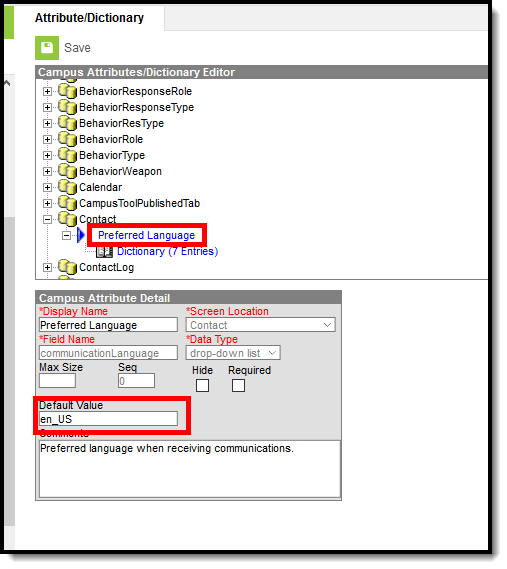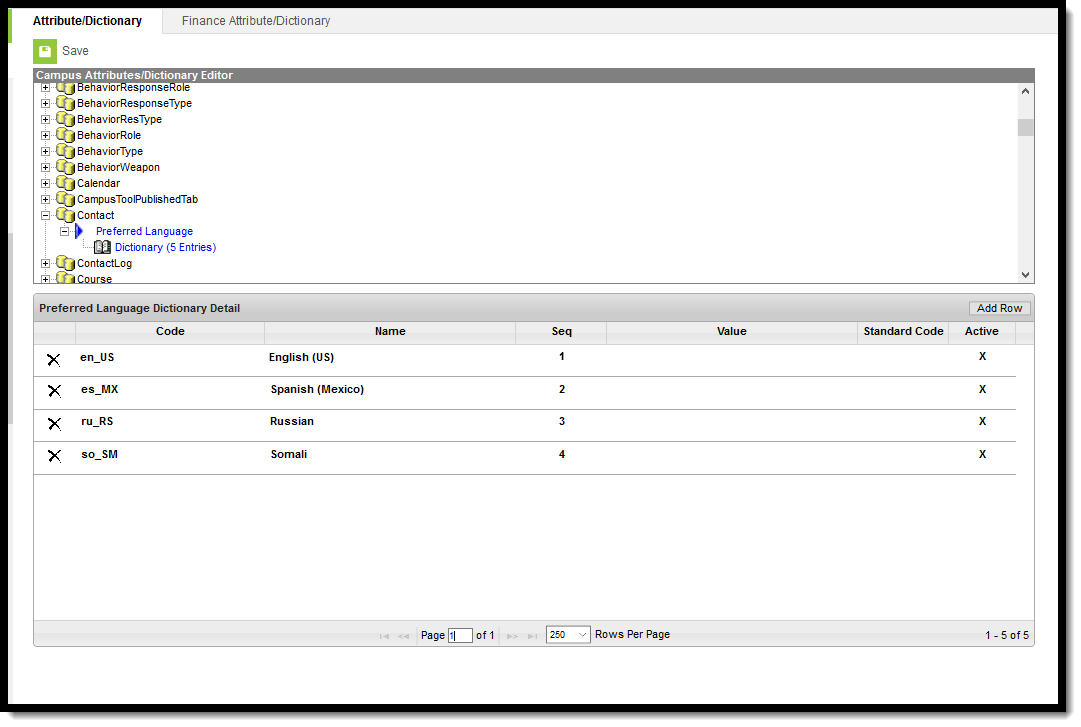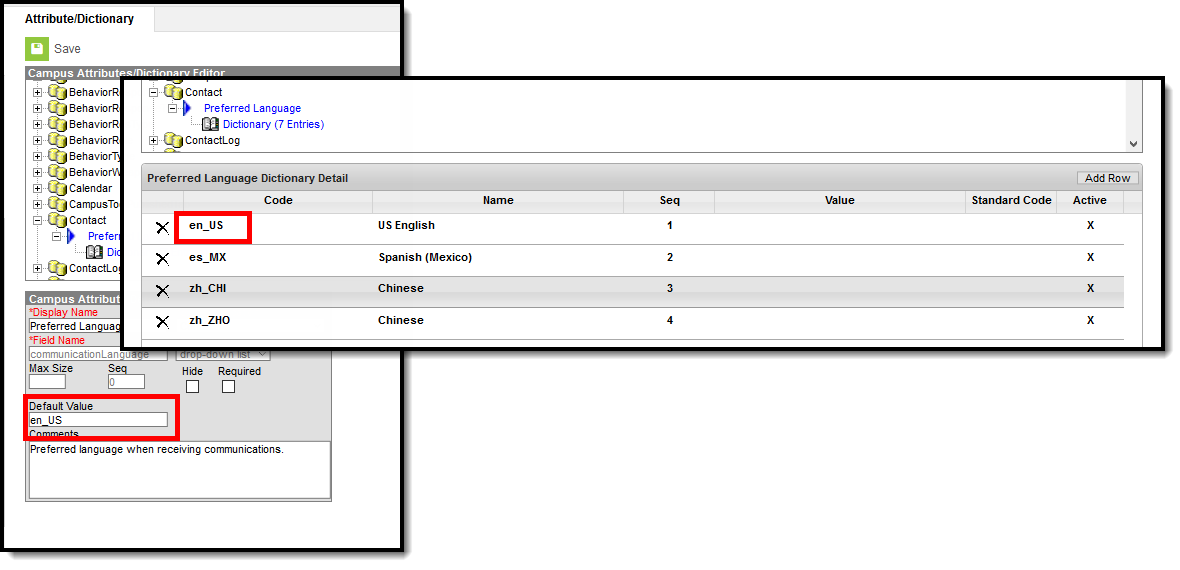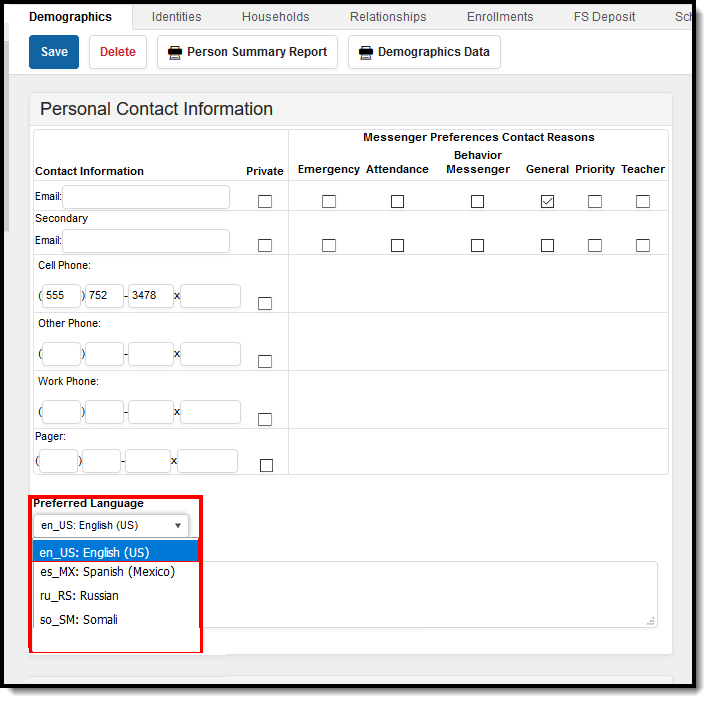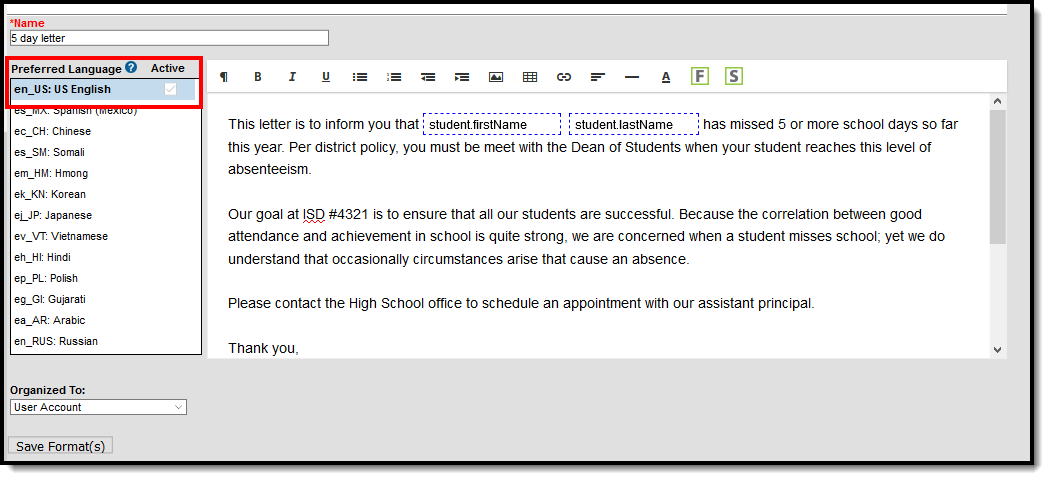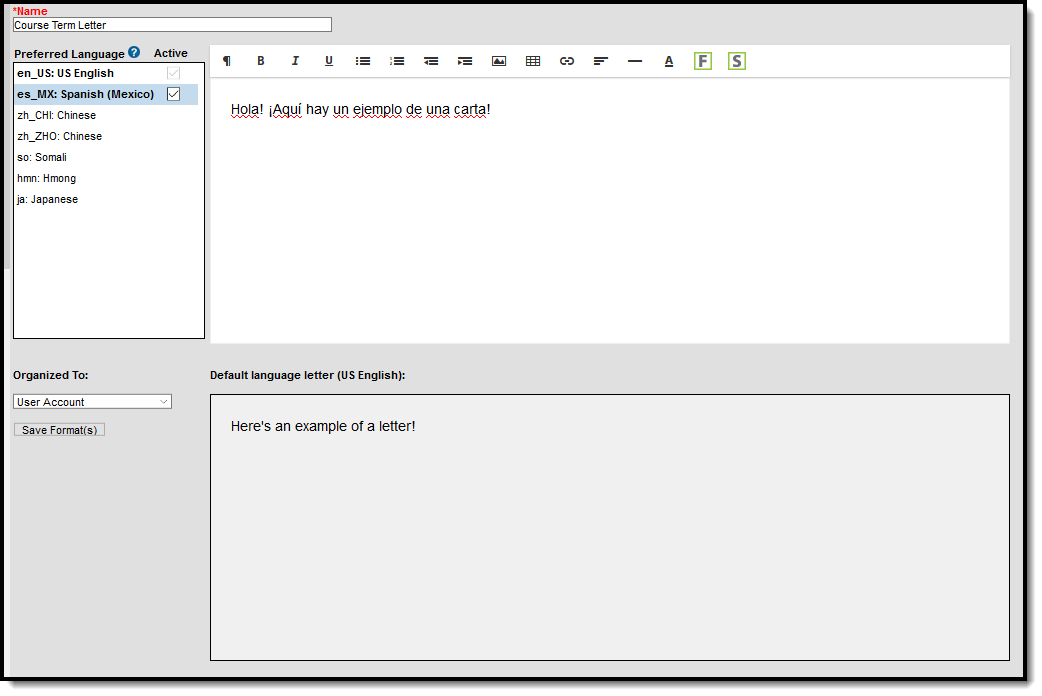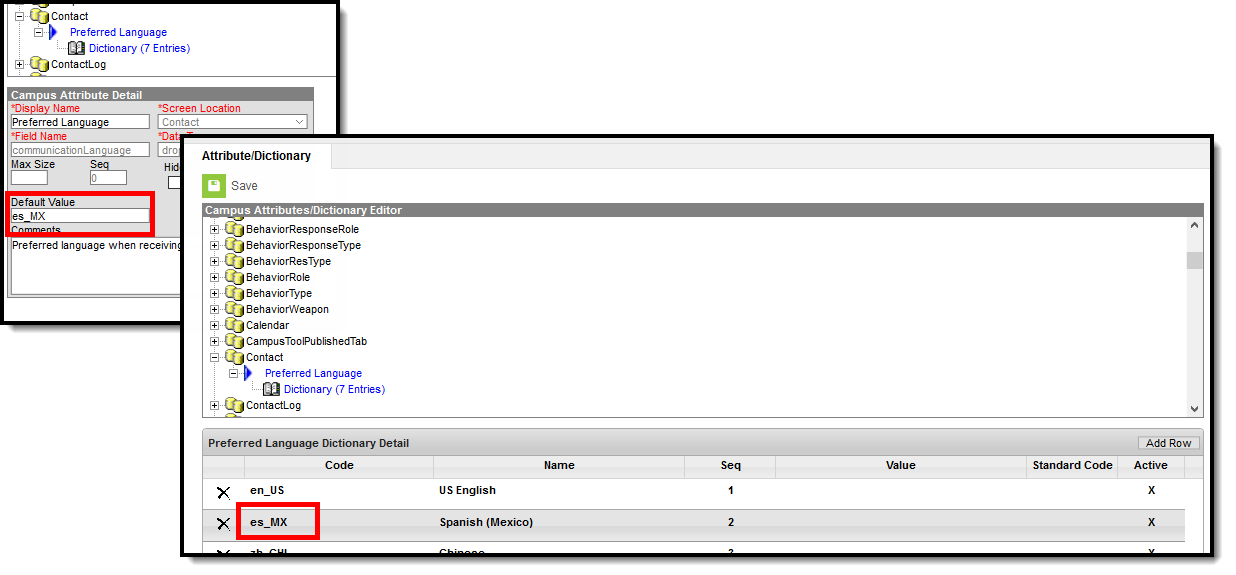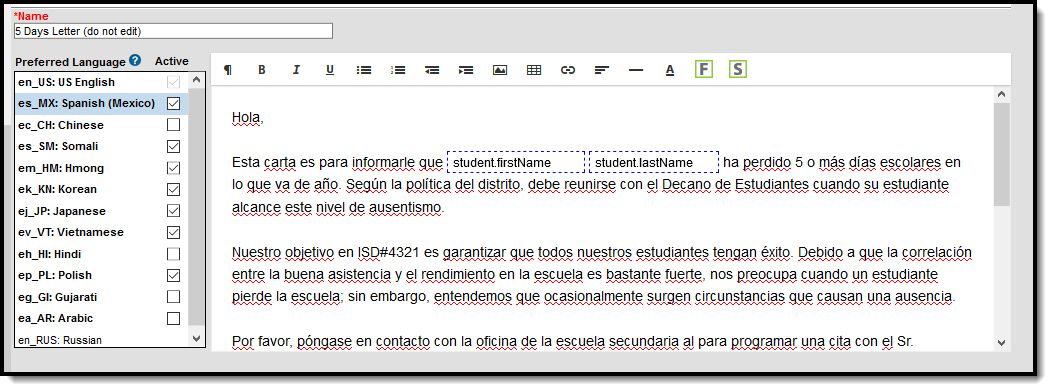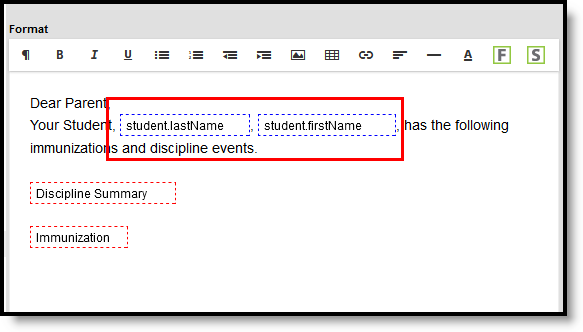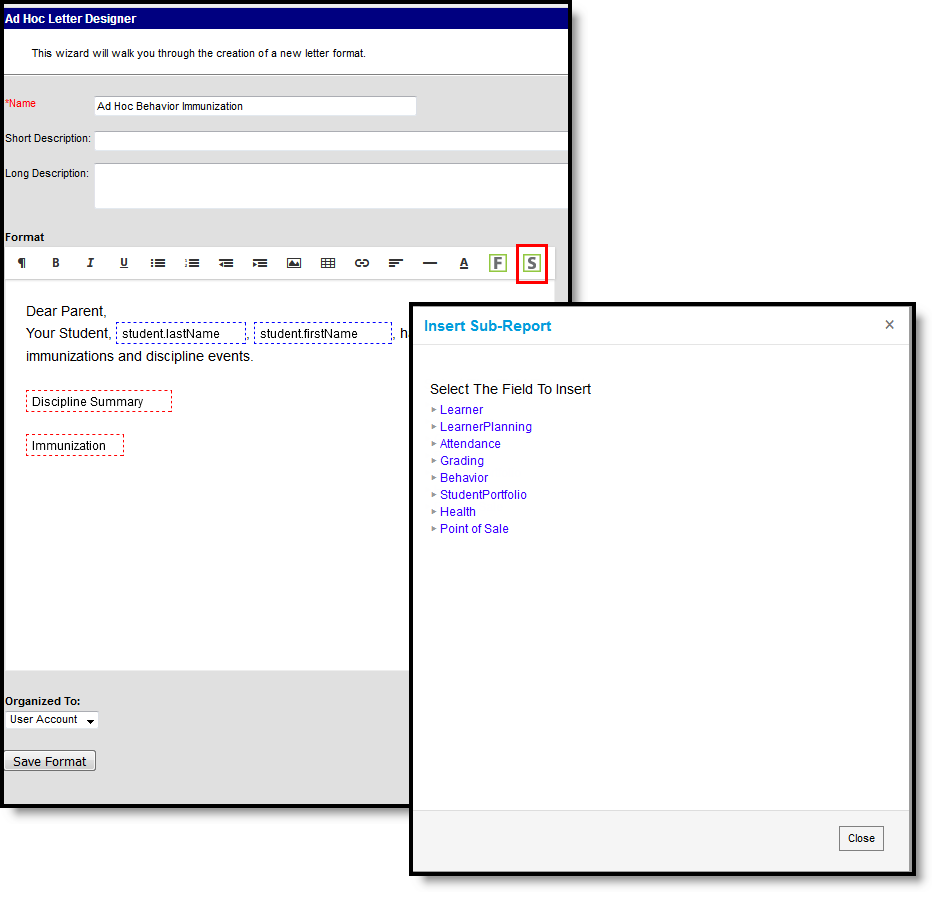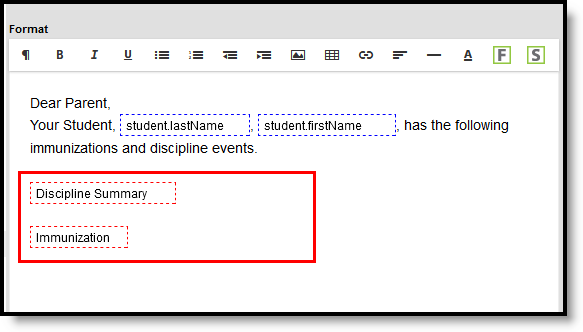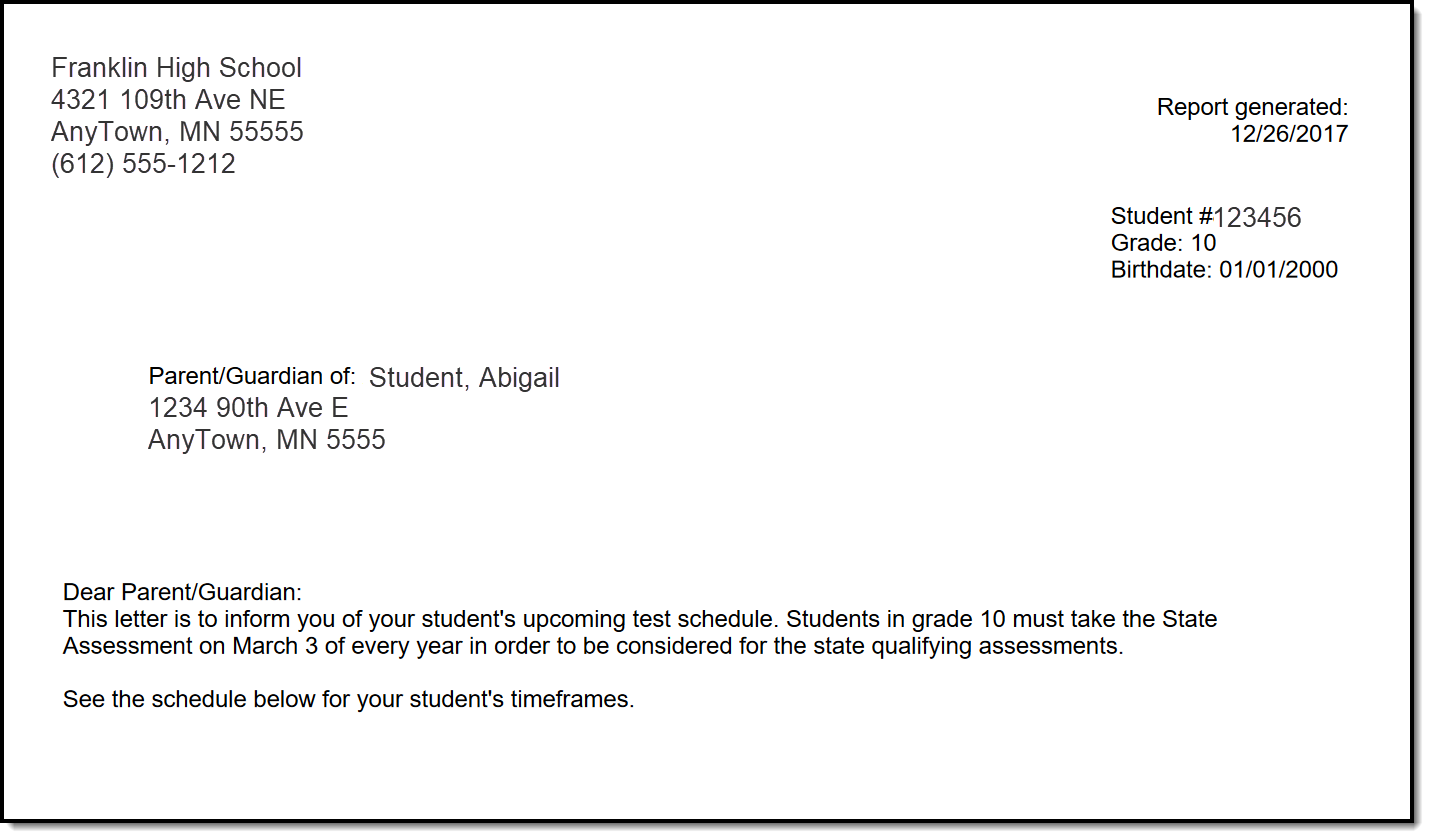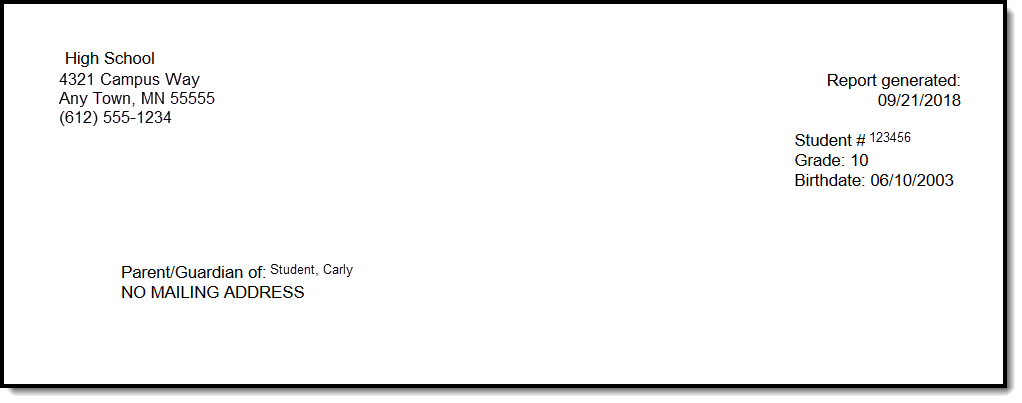Classic View: Ad Hoc Reporting > Letter Designer
Search Term: Letter Designer
The Letter Designer allows districts to create custom reports or letters using a WYSIWYG editor. Letter formats created within the Letter Designer can be used by many users and generated as many times as desired.
Letter Designer Editor
Create a New Letter Format
- Enter a Name. This is used to identify the letter within the Letter Designer and Letter Builder tools.
- Enter a Short and/or Long Description about the letter. Information written within these fields will display for users when modifying or editing the report. Text entered in the Long Description field will display on screen when the filter is selected within the Letter Builder and Letter Designer tools.
- Select the Font, Size, Font Color and any other formatting options within the text format bar.
- Begin writing the letter within the text field. To include dynamic Campus Field options and sub-reports, select the two buttons on the far-right side of the text format bar. See the Campus Field and Sub-Report Options section below for more information.
- Select a user group in the Organized To field. This field allows users to designate which user group has rights to view and generate this letter format.
- Select the Save Format button. The report format is now saved and available for use in the Letter Builder tool.
See the Letter Formats section below for more information about these options.
New Letter Format
Users are directed to the WYSIWYG editor. Standard text formatting options are available.
Inserting an Image into a Letter
Images in any of the approved formats can be added to letters. If you have trouble with a .JPEG image in FOP, try opening it with an image processing program (such as Photoshop or Gimp) and then save it. Specifying 24-bit color output may also help.
For the PDF and PostScript renderers, most .JPEG images can be passed through without decompression. Grayscale, RGB, and CMYK color spaces render properly; however, for other output formats, the .JPEG images have to be decompressed.
Refer to the WYSIWYG Editors article for more information.
Letter Format Editor
Preferred Language Setup
This format screen allows the input of the actual body of a letter. Letters can be created in several languages (see the Preferred Language Letter Setup section below). A school can create an Attendance letter in however many languages are needed, but it must first be entered in the selected Default Value.
Infinite Campus does not provide translation services.
Districts must use their own resources when creating communication to parents/guardians, students, staff, etc. in another language.
Letters must exist in the assigned default language (see Step 1). Text can be entered for additional languages, as needed for the district's population. Two things must be done:
- A language must exist in the Attribute/Dictionary and be marked active in the Attribute/Dictionary tool.
- A language must be assigned as the Preferred Language on the Personal Contact Information editor on the Demographics tab.
Existing language codes should not be modified. Access to letters is lost until the original code is recreated. If that language code is assigned to any person, that assignment is lost as well.
Step 1. Enter the Preferred Language Default Value
PATH: System Administration > Custom > Attribute/Dictionary
Enter the desired Default Value for the Preferred Language. This value is used to show the Default Language Preview when creating letters in other languages, and if no Preferred Language has been assigned to an individual (Step 3), letters generate in this default language.
- Expand the Contact object.
- Click on Preferred Language element. A Campus Attribute Detail editor displays.
- Enter the appropriate Default Value. This could be en_US, es_MX, or another abbreviation that matches the Code assigned to the Languages entered in the Dictionary list. The entered value must match the Dictionary Code for that language.
Preferred Language Default Value
Step 2. Add Language To Attribute/Dictionary
PATH: System Administration > Custom > Attribute/Dictionary
Languages available here are used in the Preferred Language Selector and control the list of languages.
- Expand the Preferred Language attribute and select Dictionary. A Preferred Language Dictionary Detail editor displays.
- Click the Add Row button in the far right corner of the Detail editor.
- Enter a Code, Name and Sequence for the language.
- Mark the language as Active.
- To add more languages, click the Add Row in the right hand corner, and repeat steps 3 and 4.
- Click the Save icon when finished.
The Language Code can be up to 15 characters in length.
Attribute Dictionary - Preferred Language
All languages except en_US and the language identified in the Default Value field can be added or removed. As the default preferred language, it is the assumed language when an individual does not have a Preferred Language assigned. Letters do not generate at all if this language is removed. The Code entered in the Dictionary must match the Default Value.
Default Value Matches Dictionary Code
Because of a configuration with Email Messenger settings, en_US should never be removed from the Preferred Language Dictionary.
Step 3. Assign Preferred Language to Parent/Guardian
PATH: Census > People > Demographics > Personal Contact Information
Assign the Preferred Language to the parent/guardian who receives an attendance letter. This field can be assigned to all persons in Campus, as well. It's used to send other sorts of messages to parents/guardians, staff and students.
Parents/guardians can also select the Preferred Contact Language on the Contact Preferences editor in the Campus Portal.
Preferred Language Assignment
Step 4. Create the Letter in the Default Language
Create the letter in the Default Language.
Preferred Language Display
Default Language: English
In the following example, en_US: US English is the Default Language.The Attribute/Dictionary has been entered as follows:
- Preferred Language Default Value: en_US
- Preferred Language Dictionary Value Code: en_US
When the same letter is created in another language, the English version displays as the Preview.
Default Language: es_MX
In the following example, es_MX: Spanish (Mexico) is the Default Language.The Attribute/Dictionary has been entered as follows:
- Preferred Language Default Value: es_MX
- Preferred Language Dictionary Value Code: es:_MX
Spanish Default Language Setup
When the same letter is created in another language, the Spanish version displays as the Preview.
Preferred Language in Spanish Letter Preview
When finished, choose the applicable Organized To: option and click the Save Format button. Follow your district's standard procedure to print and generate attendance letters. Letters in English and letters in non-English generate in the same collection of letters. When a parent/guardian is assigned a Preferred Contact Language that is not English, the letter prints in that language.
Step 5. Create the Letter in Additional Languages
After creating the letter in the Default Language, enter text for this same letter in a different language by selecting the language in the Preferred Language list and type/paste translated text into the WYSIWYG editor. That language becomes bold, and an Active checkbox becomes available. A language version of the letter is only a draft until the Active checkbox is marked.
When it is determined that the draft letter can be sent, mark the Active checkbox, indicating the letter is now ready to print for those individuals assigned that Preferred Language.
Letter in Spanish
Repeat these steps for the other languages in which letters need to be available.
Please adhere to any district policy that may exist for what needs to be included in the letters.
Step 6. Send the Letters
A letter is sent for each distinct Preferred Language associated with the parents/guardians in the household marked to receive mailings. In the example below, one of the student's guardians receives a letter in Spanish, because that is the Preferred Contact Language for that guardian, and another of the student's guardians at a different mailing address receives the same letter in English. If there are two parent/guardians in the household assigned the same Preferred Language, one letter generates for the household.
Letters in Multiple Languages
There may be certain foreign language characters that don't line up properly with other text when using the Campus Fields or when fonts are mixed (like using phone numbers alongside non-English characters). Try adding additional returns between lines.
Information in the letter sub-reports uses data stored in the AttendanceDayAggregation table. This means that attendance data for the current date is accurate as of the previous night's attendance calculation, or the last time the Attendance Aggregation Refresh was run. If needed, the Attendance Aggregation Refresh tool can be run to force an attendance recalculation to pull in the current day's data.
Campus Field and Sub-Report Options
Using Campus Fields and Campus Sub-Reports in letters allows the reports to dynamically pull and display specific student data for each student within the generated letter.
Any fields displaying in red text have been deactivated. Use the Element Replacement tool to replace them with updated fields.
Campus Field Options
To include Campus fields within a letter, select the small icon on the right-hand size of the text format bar.
Once the Campus field options icon is selected, users are presented with the Campus Field Properties editor. Much like other Ad hoc field editors, users are able to select Campus fields related to student data.
Insert Campus Fields
When adding Custom Attributes to letters, Custom Attributes cannot contain special characters.
To insert Campus fields within the letter, select the field from the Campus Field Properties editor. The selected field will appear within a dotted blue-lined box in the text field.
Campus Fields Display
In the example above, a student's first name and last name are pulled into the report. Every time this report is generated, each student being reported will pull their unique data for these fields into the letter.
Campus Sub-Report Options
To include Campus sub-reports within a letter, select the small icon on the right-hand size of the text format bar.
Campus Sub-report Selection
Once the Campus sub-report options icon is selected, users are presented with the Campus Sub-Report Properties editor.
To insert a sub-report within the letter format, select the sub-report from the Campus Sub-Report Properties editor. The sub-report will appear within a dotted red-lined box in the text field.
Campus Sub-report Display
Sub-Report Options
The following table lists the sub-report options for each area.
| Area | Sub-Reports |
|---|---|
| Learner | Student Schedule Active and Dropped Student Sch |
| Learner Planning | Course Requests Course Plan |
| Attendance | Period Mark Summary Course Mark Summary Whole/Half Day Summary Exact Day Summary Single Day Count Summary |
| Grading | Grade Detail Term GPA Summary |
| Behavior | Discipline Summary Behavior Summary |
| Student Portfolio | Cumulative GPA and Class Rank |
| Health | Immunization Health Screening Concussion Health Screening Dental Health Screening Hearing Health Screening Scoliosis Health Screening Vision |
| Point of Sale | POS Account Balance |
When using sub-reports in letters, please note the following:
- All behavior data is included when adding either of the sub-reports.
- A field only displays if there is data for that field. If a field is chosen from the sub-report but there is no saved data for that student, information for that field does not display.
- A sub-report option only displays if the district/school records that data.
Letter Formats
Users have the ability to generate letters in Blank Form or Addressed Form Letter format. The Blank Form Letter format will generate the letter exactly as it was created within the Letter Designer.
Blank Form Letter Format
The Address Form Letter format will generate the same information as the Blank Form format but include the student's address information at the top. This format is useful for letters printed and mailed to parents/guardians.
Address Form Letter Format
For students who do not have a mailing address, a letter still generates for them. Like in the Preview of the attendance letters, the student's name is listed on the summary of who receives a letter, but instead of an address, the words NO MAILING ADDRESS displays where the address would otherwise display. Letters print for the student with the same NO MAILING ADDRESS indication.
No Mailing Address Display on Letter Print
No Mailing Address is determined by the Mailing checkbox marked on the Household associated with the Address.
Address Location Detail - Mailing Checkbox



